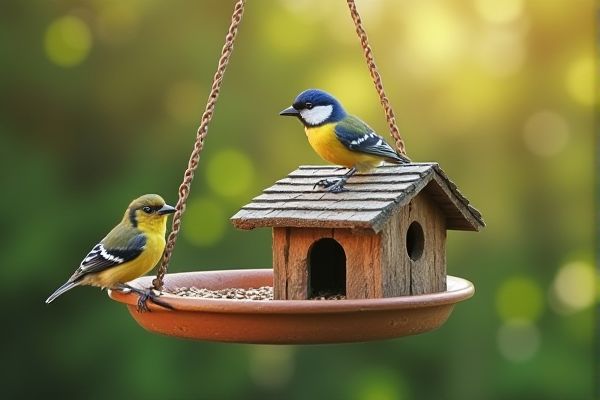
A bird feeder provides essential nourishment to attract a variety of bird species, while a bird bath offers a refreshing water source for drinking and bathing, both enhancing your garden's wildlife habitat. Discover how to choose the right option for your outdoor space to create a welcoming environment for birds by reading the rest of the article.
Table of Comparison
| Feature | Bird Feeder | Bird Bath |
|---|---|---|
| Purpose | Provides food to attract birds | Provides water for drinking and bathing |
| Attracts | Seed-eating birds like finches, sparrows | All bird types needing water |
| Maintenance | Regular cleaning; refill seeds | Frequent water changes; clean basin |
| Placement | Mounted or hanging in shaded, accessible areas | Ground level or elevated, away from predators |
| Benefits | Supports bird feeding, observation | Promotes bird hydration, health, and hygiene |
| Cost | Generally lower with simpler designs | May vary; some designs more expensive |
Introduction to Bird Feeders and Bird Baths
Bird feeders provide a reliable source of food for various bird species, attracting them to gardens and outdoor spaces, while bird baths supply essential water for drinking and bathing, supporting bird health and hygiene. Different types of bird feeders, including platform and tube feeders, cater to specific bird diets, whereas bird baths come in diverse materials like ceramic and metal to suit garden aesthetics and bird preferences. Both feeders and baths play complementary roles in creating a bird-friendly environment by addressing nutritional and hydration needs.
Benefits of Bird Feeders for Backyard Birds
Bird feeders provide a consistent and reliable food source, helping backyard birds maintain energy levels, especially during harsh weather or migration periods. By attracting a variety of species, bird feeders enhance biodiversity and create opportunities for birdwatching and ecological study. Your backyard can become a vital refuge that supports bird health, breeding success, and overall ecosystem balance through regular feeding.
Advantages of Bird Baths for Wildlife
Bird baths provide essential water sources for drinking and bathing, helping birds maintain healthy feathers and regulate body temperature. Unlike bird feeders, bird baths attract a wider variety of wildlife, including insects and small mammals, supporting biodiversity. They also encourage natural behaviors and create a peaceful ecosystem-friendly backyard environment.
Key Differences Between Bird Feeders and Bird Baths
Bird feeders primarily provide nourishment by dispensing seeds or nectar, attracting various bird species looking for food, while bird baths offer a water source for drinking and bathing, crucial for birds' hygiene and hydration. The design of bird feeders often includes seed trays or tubes, whereas bird baths feature shallow basins or bowls to accommodate birds safely. Your choice between a bird feeder and bird bath should consider the specific needs of local bird species and the environment you want to support.
Attracting Birds: Feeder vs Bath Effectiveness
Bird feeders attract a wide variety of bird species by offering easy access to seeds, suet, or nectar, making them highly effective for feeding-focused birdwatching. Bird baths primarily attract birds seeking water for drinking and bathing, which is essential for their hygiene and hydration but may bring fewer species compared to feeders. Combining both feeders and baths creates the most diverse and active bird habitat, maximizing attraction and supporting birds' nutritional and water needs.
Maintenance and Care Requirements
Bird feeders require regular cleaning every two weeks to prevent mold and disease, especially when using seed types that retain moisture. Bird baths need daily water changes and scrubbing to avoid algae growth and mosquito breeding, with ceramic and metal models demanding less frequent deep cleaning than plastic ones. Both feeders and baths benefit from location choices that minimize contamination from droppings and debris to ensure bird health and cleanliness.
Impact on Bird Health and Safety
Bird feeders can increase the risk of disease transmission among birds due to close contact and contaminated seeds, whereas bird baths require regular cleaning to prevent the spread of pathogens through stagnant water. Proper maintenance of both feeders and baths is essential to reduce exposure to parasites and harmful bacteria. Bird baths also provide crucial hydration and help birds maintain feather condition, supporting overall health and safety.
Seasonal Considerations for Feeders and Baths
Seasonal considerations influence the choice between bird feeders and bird baths, as feeders provide essential food sources during colder months when natural resources are scarce. Bird baths require regular maintenance to prevent freezing in winter, ensuring your feathered visitors have access to fresh water year-round. Your garden's ecosystem benefits most when both feeders and baths are adapted seasonally to meet birds' changing hydration and nutritional needs.
Choosing the Right Option for Your Garden
Bird feeders attract a variety of seed-eating birds, providing essential nutrition and encouraging frequent visits to your garden, while bird baths offer a water source that supports hydration and feather maintenance for all bird species. Selecting the right option depends on your local bird population and garden environment; feeders are ideal for areas with abundant seed-loving species, whereas bird baths appeal to a broader range of birds needing clean water. For optimal bird-friendly gardening, combining both a quality bird feeder filled with appropriate seeds and a clean bird bath enhances habitat diversity and bird well-being.
Combining Bird Feeders and Baths for Maximum Enjoyment
Combining bird feeders and bird baths creates a vibrant backyard ecosystem that attracts a diverse range of bird species by providing essential food and water sources simultaneously. Strategic placement of feeders near baths encourages longer visits, promoting natural behaviors like bathing and preening, which benefit avian health and increase birdwatching opportunities. This integrated approach enhances bird diversity and activity, making outdoor spaces more engaging and supportive for wild bird populations.
 homyna.com
homyna.com